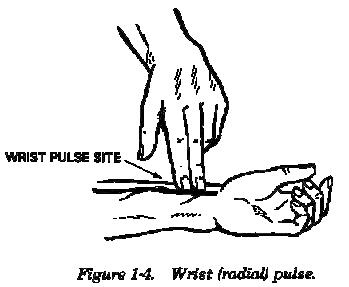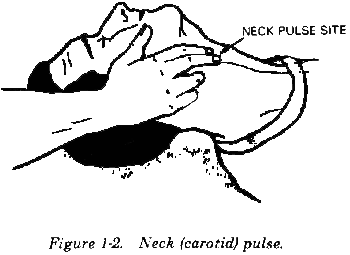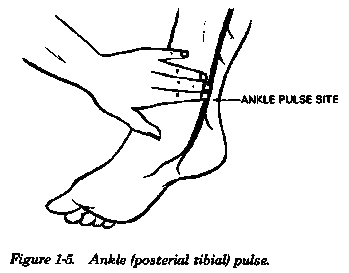|
|
|||||||||||||||
Take a PulseThe pulse is the heart rate (number of heart beats in one minute). It is always expressed as beats-per-minute, or BPM. While you certainly can count the number of beats over an entire minute, most people will shorten the process:
The last of these is the fastest and easiest, but least accurate. When there is a need for an absolutely precise pulse measurement, count for a full 60 seconds. The pulse may be obtained from a number of areas, including the wrist (radial artery), neck (carotid artery), groin (femoral artery), or foot (dorsalis pedis artery). Any place where you can feel, hear, or visualize a pulsation can be used. The presence of a pulse in certain body areas correlates reasonably well with the following blood pressures:
Home · Military Medicine · Sick Call · Basic Exams · Medical Procedures · Lab and X-ray · The Pharmacy · The Library · Equipment · Patient Transport · Medical Force Protection · Operational Safety · Operational Settings · Special Operations · Humanitarian Missions · Instructions/Orders · Other Agencies · Video Gallery · Forms · Web Links · Acknowledgements · Help · Feedback Approved for public release; Distribution is unlimited.
*This web version is provided by The Brookside Associates, LLC. It contains original contents from the official US Navy NAVMED P-5139, but has been reformatted for web access and includes advertising and links that were not present in the original version. The medical information presented was reviewed and felt to be accurate in 2001. Medical knowledge and practice methods may have changed since that time. Some links may no longer be active. This web version has not been approved by the Department of the Navy or the Department of Defense. The presence of any advertising on these pages does not constitute an endorsement of that product or service by either the US Department of Defense or the Brookside Associates. The Brookside Associates is a private organization, not affiliated with the United States Department of Defense.
© 2015, Brookside Associates, LLC. All rights reserved |
|
||||||||||||||




